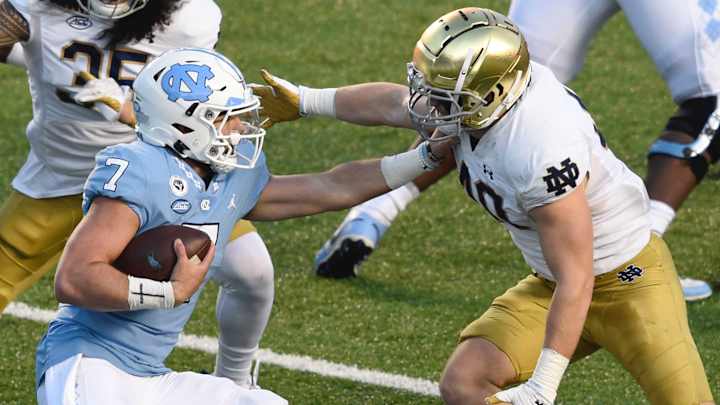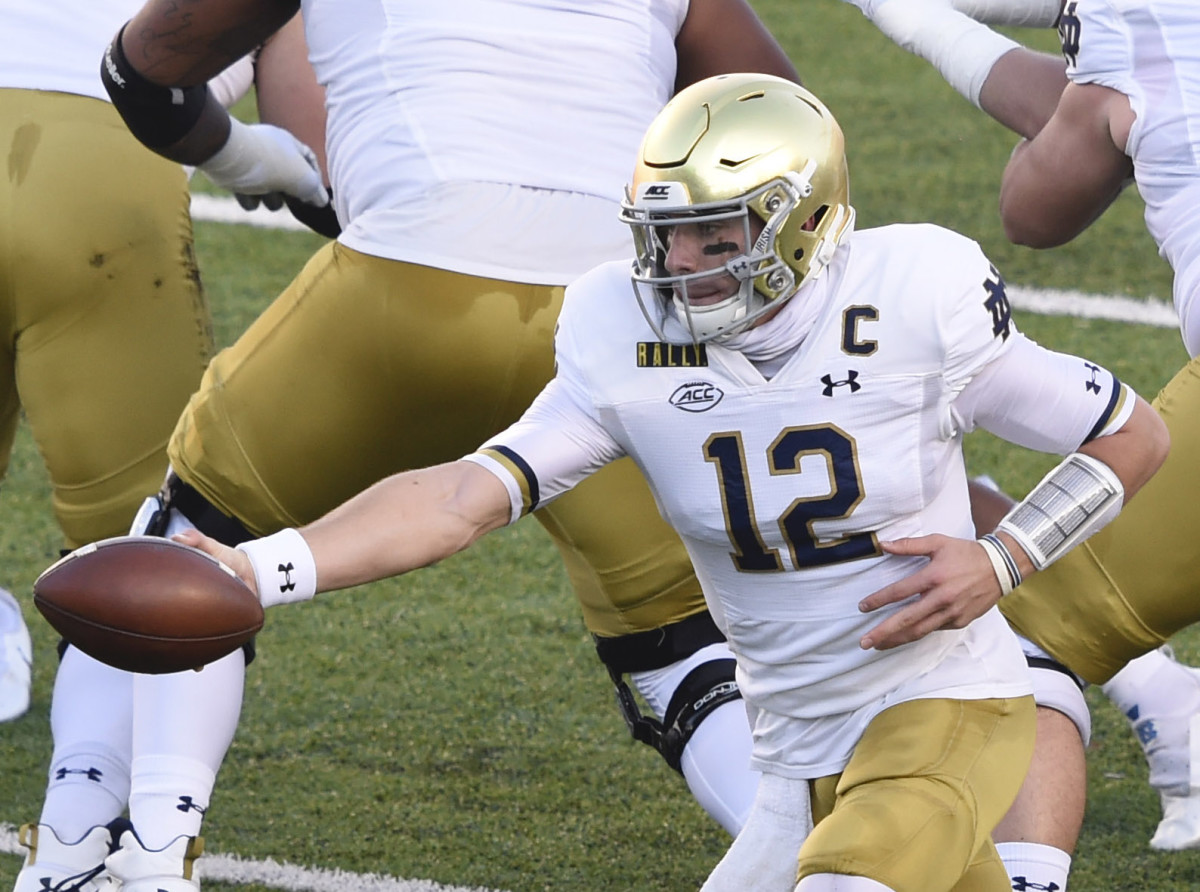Bruising and Bullish, The Irish Offer Something Missing in the Spread Age of College Football

CHAPEL HILL, N.C. — College football has eras just like the Earth itself.
You know this place was once all covered in ice. The Ice Age, they called it. The dinosaurs roamed the globe during the Jurassic Age. The Pleistocene Age came about some 300,000 years ago, when modern humans began to evolve in Africa.
But enough history, let’s get back to college football. It’s why you’re here and it’s why I’m here too. College football once had an era without passing and face guards. We’ll call it the Bloodied Age, because most players never left a game without blood somewhere—gushing from their arm, stained on their pants, matted in their hair. The sport then shifted heavily toward a specific ground-and-pound scheme: the Option Age. And don’t forget the days of the I-formation Age (one of my favorites).
For the last decade or so, college football—and football in general—has found a new system of offense, one that includes five receivers, relentless shotgun snaps, no huddles and bonanzas of points and yards.
The Spread Age has changed the game forever. It has changed defenses, too. And it has recently made the game’s greatest active coach, Nick Saban, a defensive guru himself, acknowledge that a great defense can no longer beat a great offense.
And then there’s Notre Dame. They run the ball, they play great defense and they’re undefeated.

Here on Friday night, in the clear and cool skies of North Carolina, the Irish displayed a style of ball that we (well, me at least) long for. Bruising. Bullish. Bashing.
Coach Brian Kelly has himself a club that plays a battering ram style of football—both offensively and defensively—from a bygone era. The result, thus far, has been very good. After a 31-17 win over North Carolina, the No. 2-ranked Irish are 9-0, one win away from playing for the ACC championship and three wins away from advancing to the College Football Playoff.
I know what you’re thinking. Notre Dame. Big game. Blowout.
We’ve seen it before. The Irish, in fact, are 2-18 in their last 20 games against top-5 teams. They advanced to the 2012 national title only to get smashed, 42-14, by Alabama. In 2018, Clemson whipped them 30-3 in a CFP semifinal.
And maybe this Notre Dame team is en route to the same end result. Maybe they don’t even get there. Maybe a Trevor Lawrence-quarterbacked Clemson dominates the Irish in the ACC title game. Maybe.
Or maybe not. Maybe ND’s bruising running game (14th nationally) and salty defense (9th nationally) can, in fact, suffocate the Spread Age offenses of college football’s powerhouses.
North Carolina is no powerhouse, but the Tar Heels are one of the most explosive offenses in the nation.
What the Irish did defensively on Friday was spectacular. They slowed one of the country’s most potent offenses to its lowest yardage and points total of the season. In fact, since coach Mack Brown’s return to Chapel Hill last year, no North Carolina team had been (1) held to 17 points or less and (2) lost a game—any game—by more than one score.
The Irish did both. The Tar Heels’ high-flying offense, averaging 43 points a game and 563 yards, finished with 298 total yards.
“There’s a lot to be said about holding this offense under 300 yards,” Kelly said. “That’s an outstanding defensive effort.”
In the second half, they were especially good. They were fast. They were physical. They hit really hard. They allowed just 78 yards in the final two quarters. In fact, the Tar Heels crossed midfield just once in the second half. Their six drives ended in five points and a turnover on downs. Five of those drives consumed less than 12 yards.
To recap: North Carolina scored 14 points on its first two drives of the game and scored three points on its last nine; it had 197 yards on those three scoring drives and 101 on the other eight.
This one wasn’t without intrigue, though. It was tied at 17 at halftime, and Notre Dame spent much of the second half nursing a touchdown lead, the onus on its defense, which lost in the second quarter starting safety Kyle Hamilton to a targeting foul. While up seven points or tied, the Irish defense stood tall. It kept making stop after stop after stop.
They blitzed quarterback Sam Howell, they swarmed UNC’s two stud running backs and they covered downfield. They finished with five sacks and three pass breakups.

But the Irish aren’t without offensive fireworks themselves. They don’t just batter you on the ground. Quarterback Ian Book is no slouch. He made a host of somewhat miraculous plays. He evaded sacks, ripped off a couple of big runs and kept his eyes peeled downfield for the open man. He even made a couple of underhanded pitches to extend drives.
Ian Book with some Patrick Mahomes vibes
— Sports Illustrated (@SInow) November 27, 2020
(via @Insidetheirish)pic.twitter.com/ccKvc8VIpO
Afterward, Kelly described his QB as a “playmaker.” Then the coach not-so-subtly criticized a recent top-10 ranking of college football’s quarterbacks published by USA Today. Book didn’t make the list. “The writer shouldn't be writing about football,” Kelly scolded.
Without Book’s snazzy plays, Notre Dame probably loses to North Carolina on Friday. Without that bruising running game, it loses. And certainly, without that defense, it loses.
The Irish aren’t too glitzy or glamorous. They don’t regularly roll up 300 passing days. They don’t score 50 points per outing.
They aren’t the model program of the Spread Age. And that’s why they’re a breath of fresh air.
